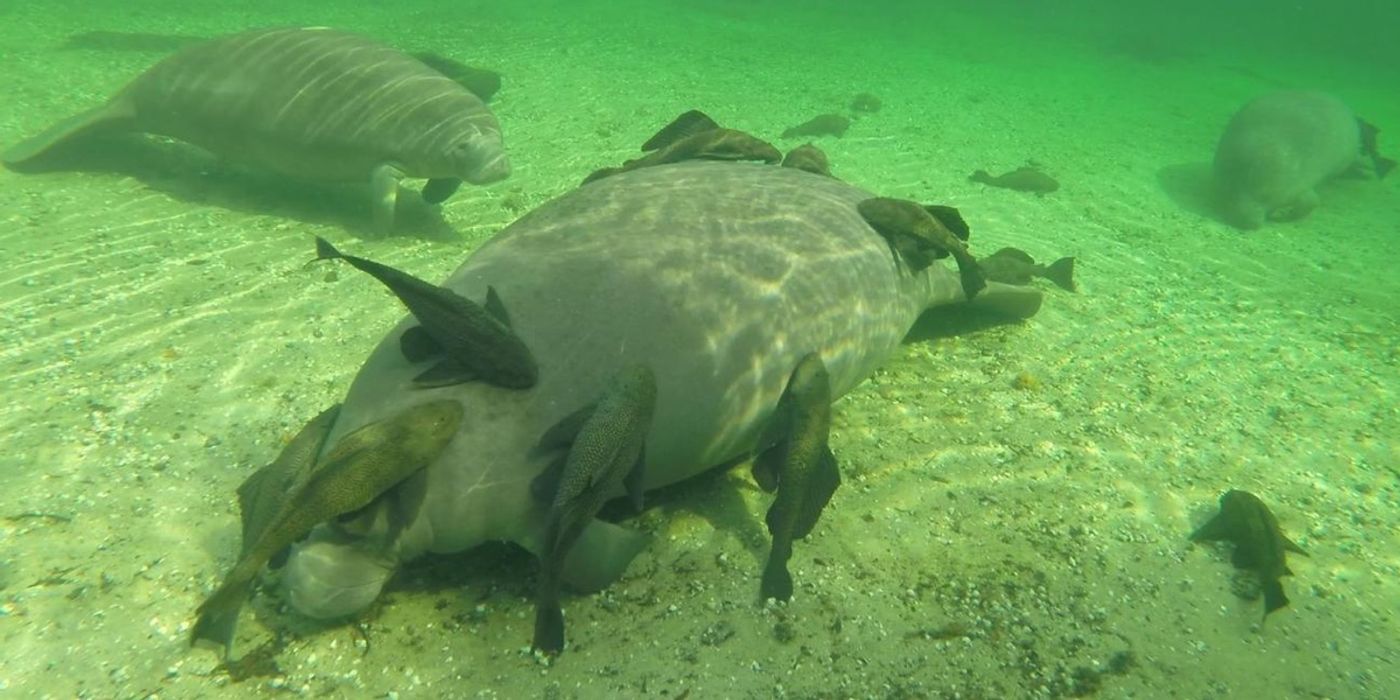Manatees in Florida Are Being Harassed by Catfish, and That's Bad
The Florida peninsula is surrounded by water on three sides, and so it’s not uncommon for the state’s residents to happen upon to the occasional wild manatee from time to time.
In most cases, witnessing a wild manatee is a breathtakingly exciting experience that has people rummaging their pockets for their camera. But some of the most recent sightings have left sight-seers a bit concerned with what they see rather than thrilled.
Image Credit: Cora Berchem, research and multimedia specialist, Save the Manatee Club
According to a recent report published by the Orlando Sentinel, local manatees are purportedly covered in dozens of dark-colored fish that appear to be ‘sucking’ on the large marine mammals. To the untrained eye, these intimidating dark fish might look like the sea’s equivalent of a blood-sucking tick, but they’re actually just sailfin suckermouth catfish.
The waters at Blue Spring maintain a warm temperature year-round, providing manatees with a means of eluding the colder waters of the St. Johns River during the cooler Winter months. On the other hand, the region is also infested with the invasive sailfin suckermouth catfish, which first appeared in the area in the 1950s.
As the two species cross paths at Blue Spring, the sailfin suckermouth catfish attach to the manatees like magnets. Despite what it looks like, the fish aren’t sucking the manatees’ blood; instead, they’re merely feeding on the algae that accumulate on the manatees’ skin.
At first glance, it appears to be a prime example of a symbiotic relationship – when two species rely on one another to survive – but perhaps unsurprisingly, the circumstances are just a bit worse than that.
Related: Florida Fish and Wildlife Conservation Commission spots 6,250 manatees
As the manatees seek refuge in Blue Spring, they realize that the region is devoid of food. The marine mammals cope with the food scarcity situation by reducing energy consumption until they return to the St. Johns River during the warmer months. But as you might come to expect, having sailfin suckermouth catfish sucking on the animals’ skin all day gives them the sense that little pests are crawling all over them.
Just as a person might reach across their body to scratch an itch in response to that ‘buggy’ feeling you get in the presence of gnats or mosquitoes, manatees respond similarly in this stressful instance. Unfortunately, twitching and moving around in response to discomfort means that the animals are expending energy that they can’t afford to, and this makes them hungrier faster.
“You can see a manatee with 20, 30 or 40 catfish on it at the worst,” Stetson University’s Melissa Gibbs explained to the Orlando Sentinel. “The catfish aren’t physically, directly damaging manatees; they annoy the heck out of them. And if manatees are twitching and moving around, they are burning calories.”
Related: Was 2018 an unlucky year for manatees?
With prey for manatees being scarce in Blue Spring, some of the hungry animals then return to St. Johns River sooner, risking themselves to cold stress before the water gets warm enough for them. Perceptibly, this is no good for a marine animal species that the International Union for Conservation of Nature recognizes as “Vulnerable” on the organization’s Red List.
It’s virtually impossible to do away with the sailfin suckermouth catfish because Florida’s waterways are a near-perfect spawning ground for the invasive species, but Gibbs frequently ventures out in her diving gear to do some spearfishing, targeting none other than the pest itself.
Sailfin suckermouth catfish hunting isn’t open to the public, but park officials and qualified biologists like Gibbs are welcome to partake. In fact, the activity is generally encouraged because it does good for the manatees by reducing the numbers of the nuisance fish.
Given the circumstances, the park is lucky to have a passionate biologist like Gibbs on the team. Without her efforts, more manatees would be annoyed to the brink of unsustainable cold stress, potentially causing issues for the beautiful animals’ population numbers.
Source: Orlando Sentinel, IUCN









